PHILIPPE BOLTON
flageolets & recorders
The French flageolet in the 19th century
1° The Flageolet à pompe

a French flageolet by Prudent Noblet
The flageolet was probably developed during the Renaissance and existed side by side with the recorder. However it did not disappear at
the end of the baroque period, and was played during the whole of the nineteenth century, and even later, in France, where it was used in dance bands and on other festive occasions.
It seems to have remained popular until around 1930. Because of its shrill sound it could easily be heard amidst other instruments.
Sound is produced in a similar way to that of the recorder. Most 19th century French flageolets have a conical windcap above the windway with, at the top, a small mouthpiece which is usually made in ivory, bone or horn and looks somewhat like an oboe reed.
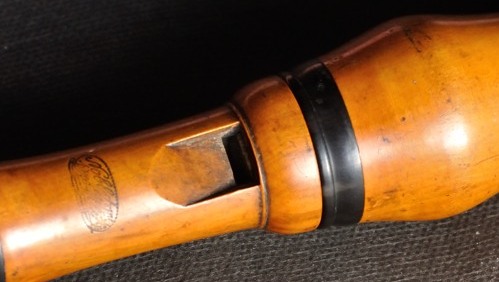
a close up view of the flageolet's labium
In his MÉTHODE COMPLÈTE DE FLAGEOLET, probably published in the early 19th century, Jules Gard gives the following information on the windcap):
There are flageolets with a windcap and flageolets with a beak. They do not differ in tone and range except that those with a windcap sound much softer and more pleasant. Moreover, they have the
advantage of not moistening as those with a beak do, for the chamber after the mouthpiece, into which one can introduce a small sponge, is intended to receive the water from the vapour of the breath.
The windcap does indeed give the flageolet a particularly refined and elegant sound. It is made up of three components, a mouthpiece, a blowpipe and a barrel which could possibly act as a resonator connected to the air column via the windway.
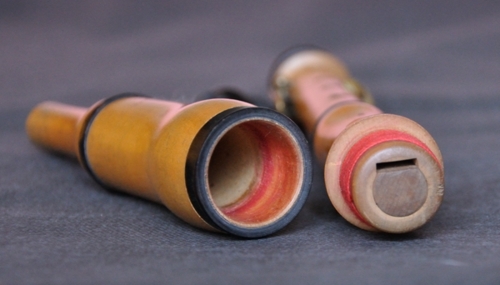
the windcap removed, showing the windway and block

a section view of the windcap, windway and labium
Eugène Roy says something similar in his METHODE COMPLETE Pour le Flageolet sans clef et avec clefs:
...those with a beak have a harsh tone whereas those with a windcap sound more like the flute and are preferable. Recently the idea came up of placing a sponge in the flageolet's windcap, filling the hollow but without blocking the airflow, in order to absorb the water released from the breath while blowing, which, without this device would clog the windway and give a hoarse sound.
From experience the sponge does not seem to be that efficient because most of the moisture forms at the top of the windcap. Even without a sponge flageolets do not appear to clog like recorders.
The French flageolet has four holes on the front and two thumb holes on the back, the upper one being used for playing the upper octave. In the 19th century it was usually tuned in A, but for practical reasons its music was often written as for a tranposing instrument in D.
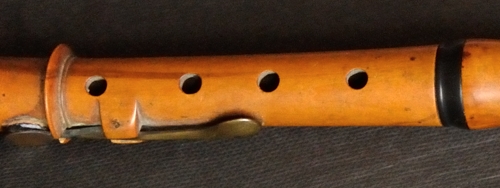
the four holes on the front of the flageolet and this instrument's key for B♭ (D#).

the two thumb holes behind the flageolet.
The English flageolet, on the other hand has its six holes in front and usually no thumb hole behind, high notes being played by increasing breath pressure.
Double flageolets were also made during the nineteenth century in England, with a single windcap for both pipes.
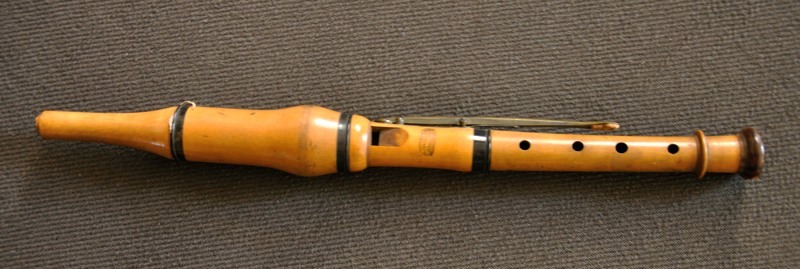
another French flageolet by Prudent Noblet with a piano key
The flageolet above, tuned to A=435 Hz was made around 1860 in La Couture Boussey, by one of the members of the Noblet family, possibly Prudent Noblet.
It is fitted with a piano or echo key, enabling the musician to play softly without loss of intonation. This is not a very common feature. The top of the windcap is damaged, and the original mouthpiece is missing.
The bore has an irregular tapered profile, narrowing downwards, as on most recorders.
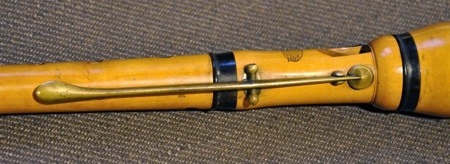
the piano key
Click here to see a picture of this instrument after restoration of the damaged part.

Prudent Noblet's stamp
Other examples of nineteenth century French flageolets

An anonymous keyless boxwood flageolet. (Mouthpiece missing)

A two keyed boxwood flageolet by Thibouville Lamy
) with keys
for E♭ (G#) and B♭ (D#) and a horn mouthpiece.

A four keyed ebony flageolet by Martin with keys for E♭ (G#) and B♭ (D#) and two trill
keys. (Mouthpiece missing, upper part of the windcap not original).

An anonymous boxwood 5 keyed flageolet in B♭ with keys for B, D, E and F# and a trill key.
The top of the windcap and mouthpiece are not original.

A five keyed ebony flageolet by Halary (ivory mouthpiece). with E♭ (G#) and B♭ (D#) keys,
two trill keys and a clé de sifflet or register key for ease of playing the highest notes.

A Boehm system flageolet by Ch. Roy
(ivory or bone mouthpiece)
2° The Flageolet à bec
However the so called flageolet à bec ("beak flageolet",without a windcap) did not completely disappear, as can be seen in this page from G. Roy's Méthode de Flageolet Ordinaire, à clés & à système Boehm revue et augmentée par A. Fugatti (1890).
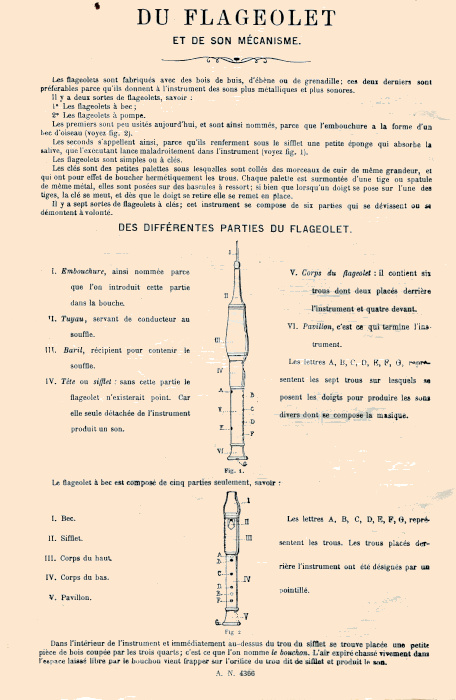
The "flageolet "à bec" below, in boxwood with horn rings, was probably made in the late 18th or early 19th century.


